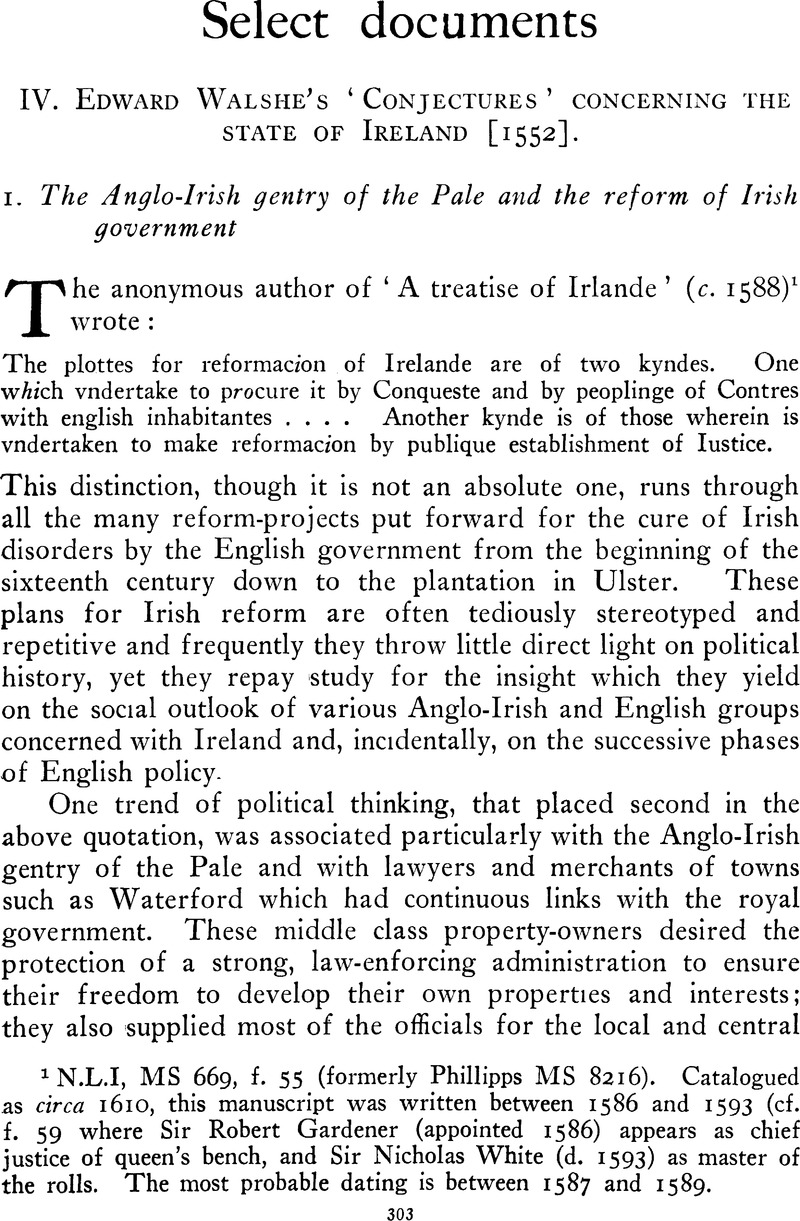Published online by Cambridge University Press: 28 July 2016

1 N.L.I, MS 669, f. 55 (formerly Phillipps MS 8216). Catalogued as circa 1610, this manuscript was written between 1586 and 1593 (cf. f. 59 where Sir Robert Gardener (appointed 1586) appears as chief justice of queen’s bench, and Sir Nicholas White (d. 1593) as master of the rolls. The most probable dating is between 1587 and 1589.
2 S.P. Hen. VIII, iii. 580–5; L. & P. Hen. VIII, xxi (pt 2), nos 155, 475 (30, 31, 33).
3 S.P. Hen. VIII, ii. 380, 391; L. & P. Hen. VIII, x, no. 1194; xii (pt 2), nos 786, 1318 (probably July 1537), 1097.
4 S.P. Hen. VIII, iii. 164, 177; L. & P. VIII. xiv (pt 2), nos 710, 736.
5 S.P. Hen. VIII, ii. 25.
6 Ibid., pp. 74–5.
7 On the beginnings of the plantation see Dunlop, R., ‘The plantation of Leix and Offaly’, in E.H.R., 5. 61–6.Google Scholar
8 P.R.O., S.P. Ire., Edw, VI, S.P. 61/1, 122–3; Acts privy council, Ire., 1556–71, p. 279.
9 It had averaged about £9,500 between 1540 and 1547 (P.R.O., S.P. Ire., folios, S.P. 65/5, 4).
10 S.P. 61/2, 25 (I). The calendar (Cal. S.P. Ire., 1509–73, p. 102) does not indicate that Cowley’s proposals, mainly concerning Wicklow, include also sections on Leix and Offaly.
11 S.P. 61/2, 46.
12 S.P. 61/2, 57.
13 See Appendix.
14 Offaly ( Curtis, E., ‘The survey of Offaly in 1550’, in Hermathena, no. 45 (1930), pp. 312–52,Google Scholar from S.P. 61/2, 65); Leix, (Ormond deeds, 1547–84, PP. 56–9).Google Scholar
15 S.P. 61/3, 3.
16 Cal. pat rolls, Ire., Hen. VIII-Eliz., pp. 229, 231–2; Cal. fiants. Irei. Edw. VI, nos 599, 661, 724 (see Dunlop, op. cit., pp. 64–5).
17 S.P. 61/3, 32, 54, 73–4; 4, 4.
18 p. 315 below.
19 p. 320 below.
20 See below, p. 315. In general the allusion is to the Roman practice of founding colonies on land confiscated from defeated enemies. The earliest of these were planted in Italy in the fourth century B.C., usually at strategically important points, e.g. along the coast or on the main strategic roads. The colonists were usually men of military age intended to serve as garrisons. Each man was given an allotment of land, the size of which varied according to the situation of the colony and the status of the colonist—larger plots being given to centurions or cavalrymen, e.g., than to infantrymen. The specific reference to an agrarian law is less easy to explain, but the law referred to is probably that of C. Gracchus in 123–2 B.C. The elder Gracchus, Tiberius, had passed an agrarian law, in 133 B.C., redistributing some of the public land in Italy- His brother, Caius, re-enacted this law and also revived the practice of founding colonies, not for strategic reasons but merely to provide more land for allotments. He was the first to found a colony outside Italy, that of Junonia on the site of Carthage. Though the founding of colonies was not strictly part of the agararian law, the two policies were complementary and are sometimes identified—e.g. by Livy, Epit., 60. The idea of founding colonies in the provinces was taken up by later reformers—thus Julius Caesar founded one on the site of Corinth and the emperors, especially Augustus, adopted it as a means of romanising the provinces. (For details see T. Frank, Economic survey of ancient Rome, passim.) There is a possibility that Walshe was also thinking of the well known agrarian law of 111 B.c. which seems to have been an attempt to clarify the situation with regard to public land in Italy and north Africa. The bronze tablets containing the fragments of this law were discovered before 1521, and though the law itself was not fully understood until much later, scholars were working on it by that date. (See Corpus inscriptionum Latinarum, i (2nd ed.), 585, and Camb. anc. hist., ix. 100, with the references there given.) I am indebted for this commentary to Mr H. Hill, Department of Classics, University College, Swansea.
21 Quinn, D.B., ’Sir Thomas Smith (1513–77) and the beginnings of English colonial theory’, in Amer. Phil. Soc. Proc, 89, 543–60.Google Scholar
22 Ed. Buckley, W.E. (Roxburghe Society, 1887).Google Scholar
23 Cal. fiants Ire., Eliz., no. 1621.
24 H.M.C, De L’Isle and Dudley MSS, i. 384.
25 P.R.O., S.P. Ire., Eliz., S.P. 63/1, 71.
26 Cal. fiants, Ire., Eliz., nos 391, 400; Cal. pat. rolls, Ire., Hen. VIII-Eliz., p. 461.
27 Cal. fiants, Ire., Eliz., nos 936–7, 1046.
28 H.M.C, rep. 10, app. v, p. 275.
29 Walter Cowley, surveyor general, see above pp. 308–9.
30 Walshe is here alleging that members of the king’s council were accustomed to receive retainers from certain Irish magnates. The allegation has not been found elsewhere, but, if true, it is an interesting reversal of the position before the Henrician conquest began in 1534. Then the Englishry paid ‘black rents’ to the Irish lords for freedom from molestation; now, apparently, Irish lords were willing to bribe English officials to do them favours.
31 An elaborate attempt—the first big industrial experiment in modern Ireland—was being made at this time to exploit the silver-mines at Clonmines, co. Wexford.
32 John Dudley, created duke of Northumberland in 1551.
33 Lord deputy, 1540–7, 1550–1.
34 Lord deputy, 1547–8.
35 In 1550; see above, p. 309.